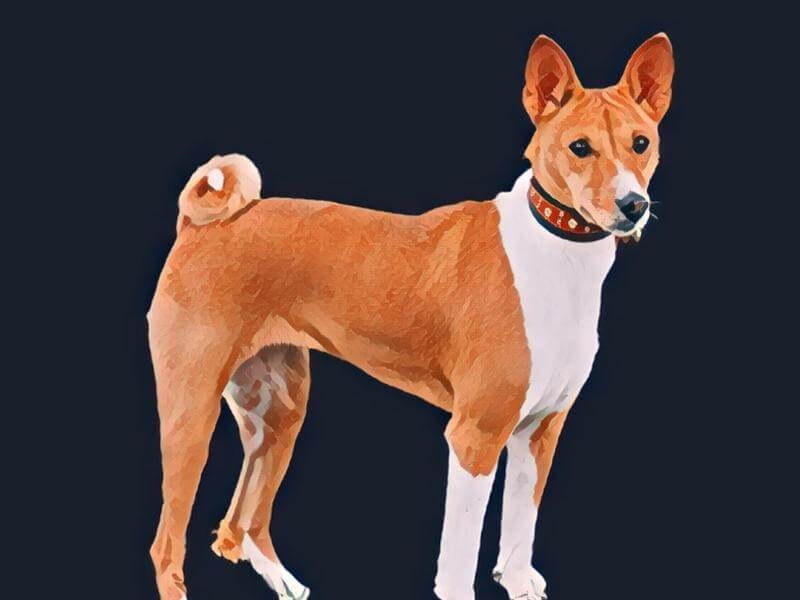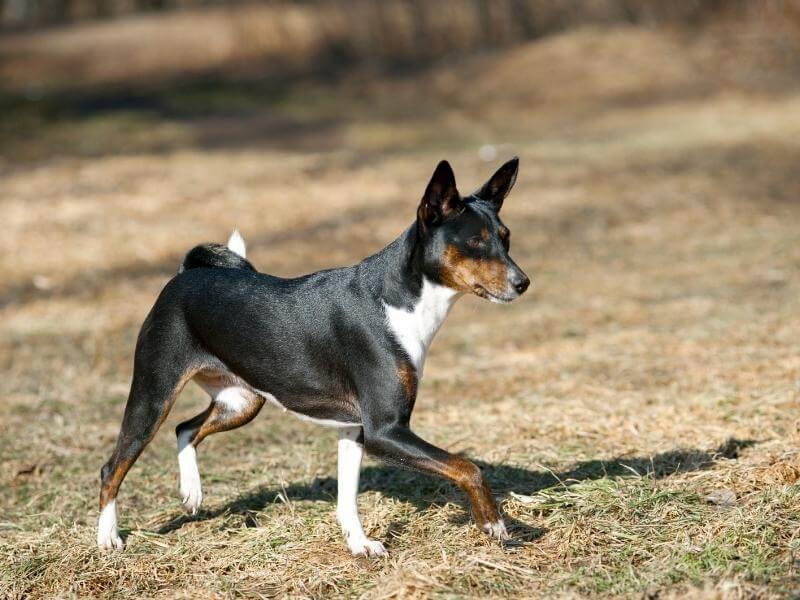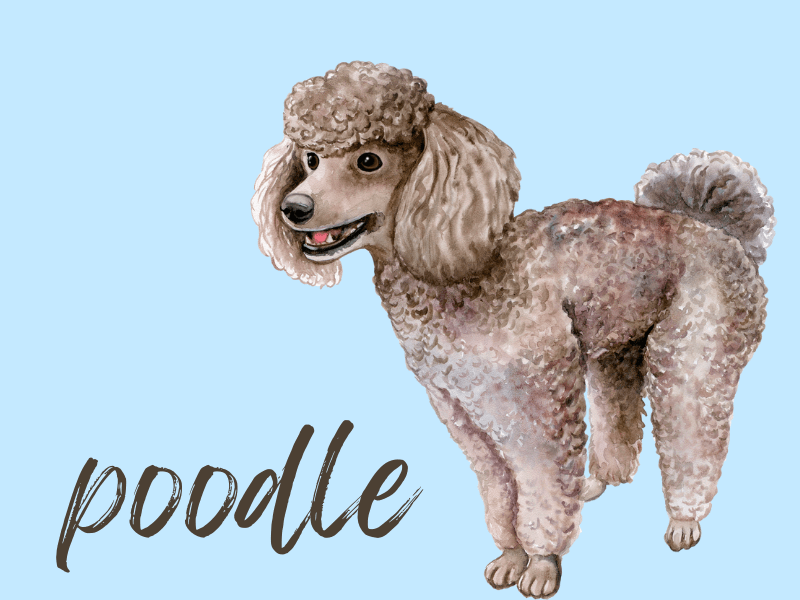The Basenjidoodle, or Basenjipoo, is a mix between a Poodle and a Basenji.
If you’re open to a regal-appearing pup that is intelligent and poised, you can’t go wrong with a Basenji-Poodle mix. This breed comes from a well-trained stock that has a history dating back to French aristocracy and ancient African hunters.
Keep reading to learn all about this new Doodle breed!
What is a Basenjidoodle?
A Basenjidoodle is a mix between the Poodle and the Basenji. Both parent breeds have a long canine history dating back hundreds or thousands of years.
The Poodle originated as a duck hunter in Germany but later became a favorite of the French aristocracy. However, the much older and smaller Basenji dates back thousands of years as an African hunter dog.
History of the Parent Breeds
The two parents of the Basenjidoodle have made their marks in dog shows worldwide. This article will discuss more of the history and origin of both breeds.
Basenji

The Basenji is known as the “African barkless dog.” While the dog may not be able to bark due to its larynx shape, that doesn’t mean it is a mute canine. On the contrary, this dog can vocalize its emotions with various sounds, including a unique yodel. Like other dogs, it won’t hesitate to growl in frustration.
If you own a Basenji, consider yourself in an elite company. This canine is the most ancient purebred dog in the world. Its extensive history goes back thousands of years to Africa, where tribe members have long used this breed for hunting.
The English made the first attempt to breed this dog, but Mother Nature made things hard. Unfortunately, it took a while for the pups to become established in the western world due to health reasons.
Since these dogs had spent thousands of years in Africa, they had not been exposed to germs, bacteria, and possible diseases elsewhere. Such a lack of immunity led to the first two waves of Basenji pups dying from the disease. Luckily, the British could finally establish the Basenji in the west by 1937.
Around 1987, breeders began to transport more Basenji pups from Africa. The previous generations had issues with Fanconi disease, so the gene pool needed replenishing.
These unique dogs are often called the “cats of the dog world.” Part of that may be because of their meticulous self-cleaning and a lack of a dog smell.
According to one breeder, the Basenji is “like a big dog and a small body.” In other words, this breed is relatively confident and knows what it wants.
If you decide to breed some Basenji pups, understand that you will have your work cut out for you. These dogs are willful, curious, and independent at a young age.

Owners should provide enough space for exercise and make sure you give them tons of socialization with other dogs and people.
There was a time when veterinarians and showrunners were not fans of these dogs. Unfortunately, the Basenji had a reputation for meanness and snapping. Luckily good training and proper breeding eased that out of them.
Keeping them cooped up in a confined space with nothing to do won’t bode well for this breed.
As one breeder noted:“These dogs command respect and don’t respond to force training.”
Give them proper respect, exercise, and space to play to their prey instinct, and you can have a great pet on your hands.
A former Basenji owner commented that the breed is “smart, loyal, fearless, spotlessly clean, and an excellent judge of character.”
Poodle

The Poodle is a famous show dog with sheep-like curly hair that often has a distinctive haircut. While its eye-catching show cut is considered very elegant, it originally served a practical use when the dog chased after ducks.
The hairstyle allowed the dog to strategically have hair in areas to maintain warmth and be hairless in other spots to move with agility in the water. Before the French nobility fell in love with them, their original German owners used them as duck hunters for hundreds of years.
To this day, Poodles are very athletic and are known as the second most intelligent dog breed, only behind the Border Collie. Poodles can run in three sizes – Standard, Mini, and Toy.
Unlike the Basenji, it will bark but won’t yap non-stop without reason. If your beloved Poodle is barking, it is probably alerting you to something such as a visitor outside.
One Poodle owner said, “Such an amazing dog, stopped three burglary attempts and made friends quickly.”
Appearance
Both parent breeds have quite distinctive hair. The Poodle has very bushy curly hair that can resemble a sheep, mainly when it grows long. The Basenji has very smooth short hair that never sheds and always comes in two colors.
Coat Type
Your Basenjidoodle mix will have slightly curly hair that can grow medium length.
This dog’s hair won’t shed at all, thanks to its parents. You will only see hair from your Basenjidoodle during a good brushing. Otherwise, don’t worry about dog hair being all over your house.
Coat Colors
Poodles come in several colors: blue, brown, silver, white, gray, apricot, red, cream, black, and a few others..
The Basenji has a shorter range of color options, such as black and white, red and white, or black brindle and white. So expect your Basenjidoodle to have a mix of these colors.
Size
A Basenjipoo is a small to medium-sized dog. So it will make a good family pet you can keep in an apartment as long as it gets exercise. Take it for at least one or two daily walks if it can’t roam outside.
Height
The average height for this dog is about 15 inches.
Weight
Females can grow to about 30 pounds. Males can reach about 40 pounds when they are fully grown.
Basenjipoo’s Personality
Your Basenjipoo is a relatively even-tempered dog. It responds very well to training and is highly intelligent. Since the dog is smart and curious, you will need to foster its curiosity by giving it plenty of toys to play with. These dogs also have a very high prey instinct from both parent breeds.
Between the high prey instinct and intelligence, it will need some space for exercise and responds well to agility courses. You can quickly train these dogs, and they can understand several commands. You may be able to teach it more than one command at a time.
This breed may be reserved to strangers at first but is overall friendly as long as it does not feel threatened.
Its relationship with other dogs is on a case-by-case basis. Some will get along with other dogs quickly, while others will be very selective. So if you take it to the dog park, keep it on a leash first to see how well it responds to other surrounding pups. In most cases, it will be ok. At worst, the dog may not want to play with another dog but is unlikely to get into a dogfight.
Children tend to love this breed that bonds quite well with the family. They are loyal and protective and make excellent watchdogs. They won’t bark to hear themselves bark. Once they understand someone is not a threat, they will be very friendly.
If you are into hunting, outdoor sports, hiking, .etc., this pup will always be willing to be your partner. They are athletic thanks to their parents and love being outside, where they can explore new things. So take them swimming or to the race track.
Traits and Characteristics

Common Health Issues
In general, this dog is a pretty healthy breed. With love, care and exercise, your pup can live a very long and productive life. However, it inherited a few health concerns from its parent breeds.
If you have this mix, be aware of the following health issues: Progressive retinal atrophy (PRA), Falcone syndrome, kidney stones, ear infections, hip concerns, and in rare cases, thyroid issues.
Lifespan
If you take care of your Basenjidoodle, expect to have it around for a long time. On average, your dog will have at least 12 to 14 years of an active and vital life. But it can live as long as 18 years old.
Final Thoughts
In this article, we took a deep dive on the Basenjidoodle dog breed. In summary, here is what I covered:
- History of the parent breeds
- Appearance of the Basenjipoo
- Size of a Basenjidoodle
- Basenjidoodle health issues
After reading all about the Basenji-Poodle mix, is it going to be your next doggo?!


